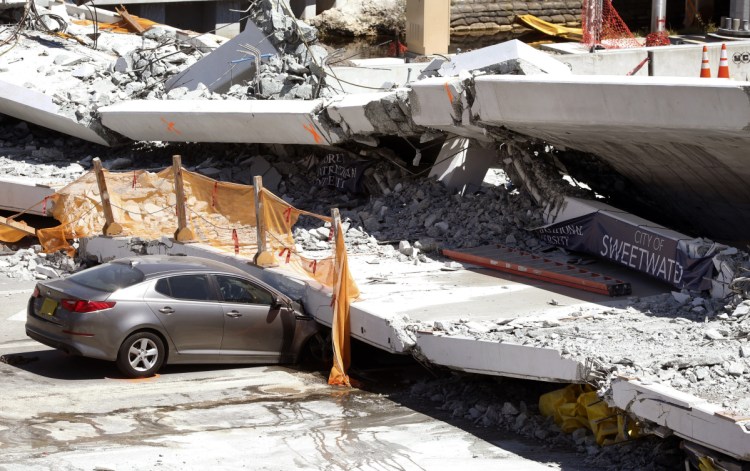MIAMI — As crews began removing bodies from beneath a collapsed pedestrian bridge Saturday, a victim’s uncle raged against what he called the “complete incompetence” and “colossal failure” that allowed people to drive beneath the unfinished concrete span.
“Why they had to build this monstrosity in the first place to get children across the street?” said an anguished Joe Smitha, whose niece, Alexa Duran, was crushed in Thursday’s collapse at Florida International University. “Then they decided to stress-test this bridge while traffic was running underneath it?”
Authorities say at least six people were killed when the structure fell onto a busy six-lane road connecting the campus to the community of Sweetwater. Crews removed two cars containing three bodies Saturday, but officials said there were still at least two more victims beneath the rubble.
“Right now we’re just chipping away,” said Miami-Dade Police Director Juan Perez.
The Miami-Dade Police Department confirmed the names of four victims Saturday.
Rolando Fraga Hernandez and his gold Jeep Cherokee were pulled from the wreckage Saturday. Later in the morning, the bodies of Oswald Gonzalez, 57, and Alberto Arias, 54, were found inside a white Chevy truck.

Six crosses are placed at a makeshift memorial on the Florida International University campus in Miami. Associated Press/Jennifer Kay
Navarro Brown was pulled from the rubble Thursday and later died at the hospital.
Authorities have not released Duran’s name, but her family said she died. The FIU freshman was studying political science.
The National Transportation Safety Board has confirmed that crews were applying what’s known as “post-tensioning force” on the bridge before the failure. Authorities are investigating whether cracking that was reported just before the span fell contributed to the accident.
Experts interviewed by The Associated Press were mixed on the significance of those reported cracks.
Amjad Aref, a professor with the University of Buffalo’s Institute of Bridge Engineering, said they should have been “a big red flag.”
“Bridges are really very vulnerable when they are under construction, when there are just pieces,” he said. “It’s like still a flimsy structure. And when you see cracks, somebody has to raise really a big flag and say, ‘We need to do something. We need to figure out what’s happening quickly and do any mitigating actions to prevent further progression of damage and ultimately collapse,’ as we saw here.”
But Ralph Verrastro, principle of Naples-based Bridging Solutions, was not surprised to hear about cracks, and said it was not necessarily a problem.
“Any bridge with concrete, that’s made of concrete, there’s always cracks,” said Verrastro, who has been an engineer for 42 years. “If they had concerns that something was going on for that main span, then they would have called the sheriff or the police and closed the road. I would be very surprised if it’s determined that they were taking a chance and trying to do something under traffic.”
Comments are not available on this story.
Send questions/comments to the editors.


